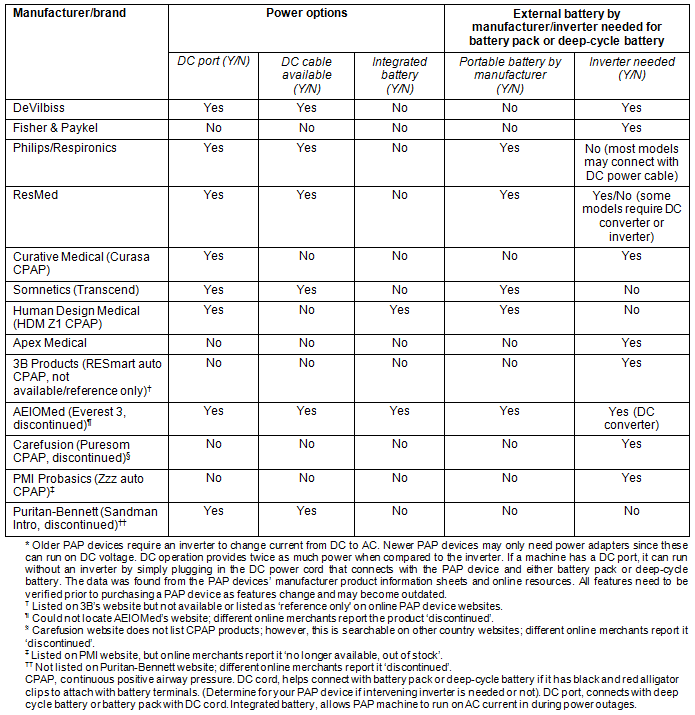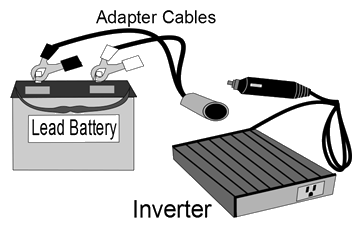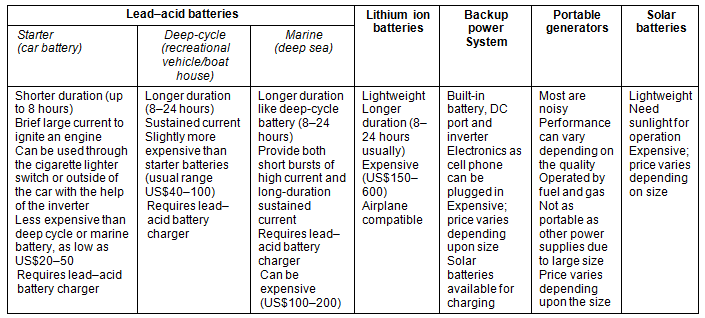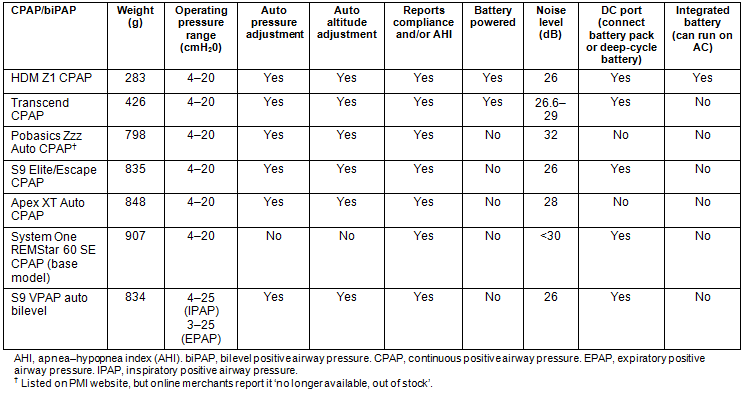Obstructive sleep apnea (OSA) is a chronic disorder of involuntary disruption of airflow in sleep, leading to inadequate gas exchange or cortical arousals, resulting in excessive daytime sleepiness with work/school impairment. Patients with untreated OSA have a higher risk of hypertension, cardiovascular disease and stroke, as well as poor control of chronic medical conditions1-5. Positive airway pressure (PAP) devices, either continuous (CPAP) or bilevel (biPAP), are the most efficacious treatment for OSA among different treatment options available6-11. A common problem for OSA patients is powering their PAP devices when alternating current (AC) power supplies are not available (eg during power failure or lack of electricity in rural and remote areas or during camping trips, hiking, sailing, or outdoor activities, travelling to remote areas or developing countries, or during military deployment). Currently, medical literature lacks a publication to address this significant problem. The purpose of this article is to provide necessary information on portable power supply options for PAP devices in order to increase knowledge among medical providers, and hence improve healthcare outcomes in OSA patients given the high prevalence of PAP non-adherence (46-83%)12,13.
A search of scientific databases (Medline, Scopus, Web of Science, Google Scholar and the Cochrane Library) was carried out from database inception to January 2015. Keywords, MeSH terms and phrases searched included combinations of 'continuous positive airway pressure', 'travel', 'electric power supplies', 'sleep apnea', 'wilderness', 'air travel' and 'altitude.' An example of a search on Medline is ((('Continuous Positive Airway Pressure' [Mesh]) AND 'Travel' [Mesh])) OR (('Continuous Positive Airway Pressure' [Mesh]) AND 'Electric Power Supplies' [Mesh])) OR (('Wilderness'[Mesh]) AND 'Obstructive Sleep Apnea' [Mesh])). A Google search, with similar terms and phrases, was then performed, which yielded about 32 300 hits.
The search of scientific databases yielded no article on the topic of alternative portable power supply options for PAP devices; however, a few articles were found related to travel and OSA, which are referenced here in this review. Of the hits on Google, the first 20 pages were reviewed for relevance along with manufacturer websites (Table 1)14-22.
Table 1: PAP device power options based on common PAP device manufacturers*

Portable power options
Lead-acid batteries (starter, marine, and deep-cycle batteries): Lead-acid batteries are rechargeable battery systems that provide DC power and when aided by adapters can be used to power PAP devices. Lead-acid batteries can be starter, deep-cycle or marine23-25. (Table 2). All of these lead-acid batteries can be used as a source of power to run PAP devices with the help of either an inverter or direct current (DC) adapter or through the cigarette lighter. An inverter can convert the DC power from the vehicle battery to AC power, which can run the PAP device. An inverter can be either directly connected to the battery with clamps or through the cigarette lighter. New PAP machines have a DC output and a DC cable that can be used to run the PAP device by connecting the PAP device and the vehicle battery without the need for starting the engine or inverter26. When using a separate battery as the power supply, additional items are necessary, which include an adapter cable and inverter (Fig1).

Figure 1: Example of a lead-acid battery power supply setup: lead-acid battery (left), adapter cable (middle), and inverter that connects to the PAP device (right).
Table 2: Portable power supply options for PAP devices, by major and sub-categories

Lithium ion batteries: Lithium ion batteries are used as a part of sophisticated lightweight battery packs, which are easy to use, provide reliable power for 8-24 hours, are moderately cost effective and are allowed by many airlines27,28.
Backup power systems: Backup power systems (uninterruptible power source (UPS), standby generators, DC power systems) are often used in the event of a power outage; however, these can be extremely heavy. Portable backup power systems are relatively light and thus easier to transport, but they can be expensive29,30.
Portable generators: Portable generators that run on gas or other types of fuel are another power supply option. Their price varies widely, depending upon the size of the unit. A significant limitation is that they are cumbersome to transport and produce a significant amount of noise and exhaust.
Portable travel machines: The two most commonly listed lightweight travel size machines include Transcend CPAP and HDM Z1 CPAP. Some newer models of Transcend machines have overnight battery options, which can be recharged in a few hours using a solar charger. These battery packs can run the Transcend machine when the AC current is not available. HDM Z1 CPAP is the lightest machine available in the market and has a power shell integrated battery pack in case of power failure. This battery can provide eight plus hours of runtime in 14 cm of water31,32.
Public transport: When traveling by air, train or at sea, electrical outlets can be found for operating PAP devices. Power outlets may not be present on every seat, and voltage requirements may be different as well. Hence, passengers may need an adapter to convert the voltage depending upon the carrier. According to the US Air Carrier Access Act 2009 (part 382.11), passengers can use their PAP devices on airplanes as long as they provide a document of medical necessity, advance notification to the carrier, and manufacturer labeling indicating Federal Aviation Administration requirements for medical portable devices33.
Solar kits: PAP devices can be charged with compact solar panels in a variety of solar kits, which usually comprise a solar panel, attached charge storing battery device with integrated AC and DC outlets. These power systems can be expensive, depending upon the voltage capacity and desired power needs34.
Discussion
Sleep deprivation can be debilitating among CPAP users in remote areas with lack of electricity or in areas of frequent power outages. Their inability to function optimally in such situations could cause side effects of untreated OSA, including hypersomnia as well as increased risk of traffic accidents, high altitude pulmonary edema, and sudden cardiac death35-37.
Most OSA patients require nightly PAP therapy for alleviation of daytime symptoms except mild OSA patients or patients who do not have significant daytime symptoms or comorbidities. Therefore, patients with mild OSA may not need a PAP device if they are going for a short trip or if lack of electricity is only for a short duration. However, it is advisable even for mild OSA patients to use PAP every night if they are going for long trips and/or to high altitudes7,36.
OSA patients who have underlying chronic respiratory diseases and are dependent on supplemental oxygen with PAP therapy may need to take their portable oxygen concentrator with them when travelling by air or going to remote areas at high elevation as altitude exposure may exacerbate hypoxemia. The Air Carrier Access Act does allow portable oxygen concentrators for air travel; however, it is recommended for patients to confirm with their airline as well as follow country-specific guidelines for people with respiratory diseases38.
Portable PAP device power supplies (aside from generators) are generally quiet. In general, deep-cycle and marine batteries can operate a PAP device for longer periods of time than car batteries. More sophisticated portable power systems made of lead-acid batteries can run a PAP device for up to 54 hours and may need charging once a week. The price for these portable systems can be US$100-200 compared to a simple deep cycle battery, which costs less than $50. Like the deep-cycle batteries, the newer lithium ion portable battery packs are also an excellent option given the extended duration of backup power for up to 24 hours. Emergency backup power systems with integrated batteries are also a good option to use at home; however, these have a high variability of backup power, so each device would need to be reviewed for duration of power. Lightweight solar kits usually provide only a few hours of power, except in the case of larger kits, which can be heavy and expensive. Newer portable CPAP machines are a good alternative to backup power systems. A drawback is their relatively higher price (US$400-600), and they are usually not covered by all insurance companies. It should be noted that PAP devices are recommended to be used without the humidifier when they are being operated with DC power, since adding the humidifier will drain the battery faster.
There are limitations to this study. First of all, there are no identified reviews on the topic in the literature, so this information was obtained from PAP device instruction manuals, PAP device manufacturer websites and other online resources that are referenced herein. The authors made every attempt to obtain the majority of information from PAP device manufacturers as this was the most reliable source of information. The information contained in this article will help improve patient care and provides both providers and patients with current information on what is necessary to power a PAP device when there is no alternating current power supply available. Table 3 summarizes lightweight PAP devices.
Table 3: Lightest CPAP/biPAP devices (up to 1 kg)

Currently there are several portable power supply options available for PAP devices, including lead-acid batteries, portable battery packs, and battery-operated lightweight CPAP machines. To improve PAP adherence, it is vital for medical providers, especially in remote and rural settings to educate their patients about portable power supply options when there is no AC power supply available.
References
1. Somers VK, White DP, Amin R, Abraham WT, Costa F, Culebras A, et al. Sleep apnea and cardiovascular disease: an American Heart Association/American College Of Cardiology Foundation Scientific Statement from the American Heart Association Council for High Blood Pressure Research Professional Education Committee, Council on Clinical Cardiology, Stroke Council, and Council on Cardiovascular Nursing. Journal of American College of Cardiology 2008; 52(8): 686-717.
2. Peppard PE, Young T, Palta M, Skatrud J. Prospective study of the association between sleep-disordered breathing and hypertension. New England Journal Medicine 2000; 342(19): 1378-1384.
3. Dyken ME, Im KB. Obstructive sleep apnea and stroke. Chest 2009; 136(6): 1668-1677.
4. Gami AS, Howard DE, Olson EJ, Somers VK. Day-night pattern of sudden death in obstructive sleep apnea. New England Journal of Medicine 2005; 352(12): 1206-1214.
5. Good DC, Henkle JQ, Gelber D, Welsh J, Verhulst S. Sleep-disordered breathing and poor functional outcome after stroke. Stroke 1996; 27(2): 252-259.
6. Sullivan CE, Issa FG, Berthon-Jones M, Eves L. Reversal of obstructive sleep apnoea by continuous positive airway pressure applied through the nares. Lancet. 1981; 1(8225): 862-865.
7. Doff MH, Hoekema A, Wijkstra PJ, van der Hoeven JH, Huddleston Slater JJ, de Bont LG, et al. Oral appliance versus continuous positive airway pressure in obstructive sleep apnea syndrome: a 2-year follow-up. Sleep 2013; 36(9): 1289-1296.
8. Browaldh N, Nerfeldt P, Lysdahl M, Bring J, Friberg D. SKUP3 randomised controlled trial: polysomnographic results after uvulopalatopharyngoplasty in selected patients with obstructive sleep apnoea. Thorax 2013; 68(9): 846-853.
9. Certal VF, Zaghi S, Riaz M, Vieira AS, Pinheiro CT, Kushida C, et al. Hypoglossal nerve stimulation in the treatment of obstructive sleep apnea: a systematic review and meta-analysis. Laryngoscope 2015; 125(5): 1254-1264.
10. Vicini C, Dallan I, Campanini A, De Vito A, Barbanti F, Giorgiomarrano G, et al. Surgery vs ventilation in adult severe obstructive sleep apnea syndrome. American Journal of Otolaryngology 2010; 31(1): 14-20.
11. Rossi VA, Winter B, Rahman NM, Yu LM, Fallon J, Clarenbach CF, et al. The effects of provent on moderate to severe obstructive sleep apnoea during continuous positive airway pressure therapy withdrawal: a randomised controlled trial. Thorax 2013; 68(9): 854-859.
12. Weaver TE, Grunstein RR. Adherence to continuous positive airway pressure therapy: the challenge to effective treatment. Proceedings of American Thoracic Society 2008; 5(2): 173-178.
13. Salepci B, Caglayan B, Kiral N, Parmaksiz ET, Comert SS, Sarac G, et al. CPAP adherence of patients with obstructive sleep apnea. Respiratory Care 2013; 58(9): 1467-1473.
14. ResMed. ResMed Power Station II (RPS II). (Online) 2014. Available: http://www.resmed.com/us/en/consumer/products/accessories/resmed-power-station-ii-rps-ii.html (Accessed 11 December 2014).
15. Curative Medical. CPAP, bilevel, cardio-vascular, respiratory and OSA products. (Online) 2014. Available: http://www.curativemedical.com/products.html (Accessed 11 December 2014).
16. Fisher & Paykel Healthcare. CPAP devices. (Online) 2014. Available: http://www.fphcare.com/products/categories/cpaps/ (Accessed 11 December 2014).
17. APEX Medical. iCH Auto. (Online) 2014. Available: http://www.apexmedicalcorp.com/index.php?sn=4287&lang=en-global&n=66 (Accessed 11 December 2014).
18. Probasics. zzz-PAP operator's manual. (Online) 2014. Available: http://www.pmiusa.biz/sleep.html (Accessed 23 July 2015).
19. 3B Medical. RESmart® auto-CPAP. (Online) 2014. Available: http://3bproducts.com/resmart-auto-cpap/ (Accessed 11 December 2014).
20. CareFusion. Improving the safety and cost of healthcare for generations to come. (Online) 2014. Available: http://www.carefusion.co.za/ (Accessed 11 December 2014).
21. Covidien. Respiratory and monitoring solutions. (Online) 2014. Available: http://www.covidien.com/rms/brands/puritan-Bennett (Accessed 23 July 2015).
22. CPAP. CPAP machines. (Online) 2014. Available: http://www.cpap.com/cpap-machines.php (Accessed 11 December 2014).
23. eHow. Types of lead-acid batteries. (Online) 2014. Available: http://evbatterymonitoring.com/batterybook2/Types_of_Lead-Acid_Batteries.htm (Accessed 23 July 2015).
24. Northern Arizona Wind & Sun. Deep cycle battery frequently asked questions. (Online) 2014. Available: http://www.solar-electric.com/deep-cycle-battery-faq.html (Accessed 11 December 2014).
25. eHow. Marine battery vs. deep cycle battery. (Online) 2014. Available: http://www.ehow.com/about_5606295_marine-vs_-deep-cycle-battery.html (Accessed 23 July 2015).
26. Sleep Health Foundation. Travelling with CPAP. (Online) 2014. Available: http://www.sleephealthfoundation.org.au/fact-sheets-a-z/200-travelling-with-cpap.html (Accessed 23 July 2015).
27. Transportation Security Administration. Safe travel with batteries and devices. (Online) 2014. Available: http://www.tsa.gov/traveler-information/safe-travel-batteries-and-devices (Accessed 11 December 2014).
28. CPAP Supply USA. Respironics battery pack. (Online) 2014. Available: http://www.cpapsupplyusa.com/Respironics-Battery-Pack-1028869.aspx (Accessed 11 December 2014).
29. AltE Store. Xantrex XPower powerpack 1500 - portable backup powerpack. (Online) 2014. Available: http://www.altestore.com/store/Portable-Power-Systems/Xantrex-XPower-Powerpack-1500-Portable-Backup-Powerpack/p2066/ (Accessed 11 December 2014).
30. Power Solutions. DC power supplies & DC power systems. (Online) 2014. Available: http://www.power-solutions.com/dc-power-systems (Accessed 11 December 2014).
31. Transcend. Sleep apnea therapy system. (Online) 2014. Available: http://www.mytranscend.com/ (Accessed 11 December 2014).
32. Human Design Medical. The Z1? - the world's smallest, lightest, most integrated cpap. (Online) 2014. Available: http://hdmusa.com/the-z1/ (Accessed 11 December 2014).
33. Transportation Security Administration. Passengers with CPAPs, BiPAPs, and APAPs. (Online) 2014. Available: http://www.tsa.gov/traveler-information/passengers-cpaps-bipaps-and-apaps (Accessed 11 December 2014).
34. BatteryStuff.com. Solar charger/multi-use solar chargers for all applications. Available: http://www.batterystuff.com/solar-chargers/ (Accessed 11 December 2014).
35. Gay P, Weaver T, Loube D, Iber C, Positive Airway Pressure Task Force, Standards of Practice Committee, et al. Evaluation of positive airway pressure treatment for sleep related breathing disorders in adults. Sleep 2006; 29(3): 381-401.
36. Ginosar Y, Malhotra A, Schwartz E. High altitude, continuous positive airway pressure, and obstructive sleep apnea: subjective observations and objective data. High Altitude Medicine Biology 2013; 14(2): 186-189.
37. Gami AS, Olson EJ, Shen WK, Wright RS, Ballman KV, Hodge DO, et al. Obstructive sleep apnea and the risk of sudden cardiac death: a longitudinal study of 10,701 adults. Journal of American College of Cardiology. 2013; 62(7): 610-616.
38. Josephs LK, Coker RK, Thomas M, BTS Air Travel Working Group, British Thoracic Society. Managing patients with stable respiratory disease planning air travel: a primary care summary of the British Thoracic Society recommendations. Primary Care Respiratory Journal 2013; 22(2): 234-238.
